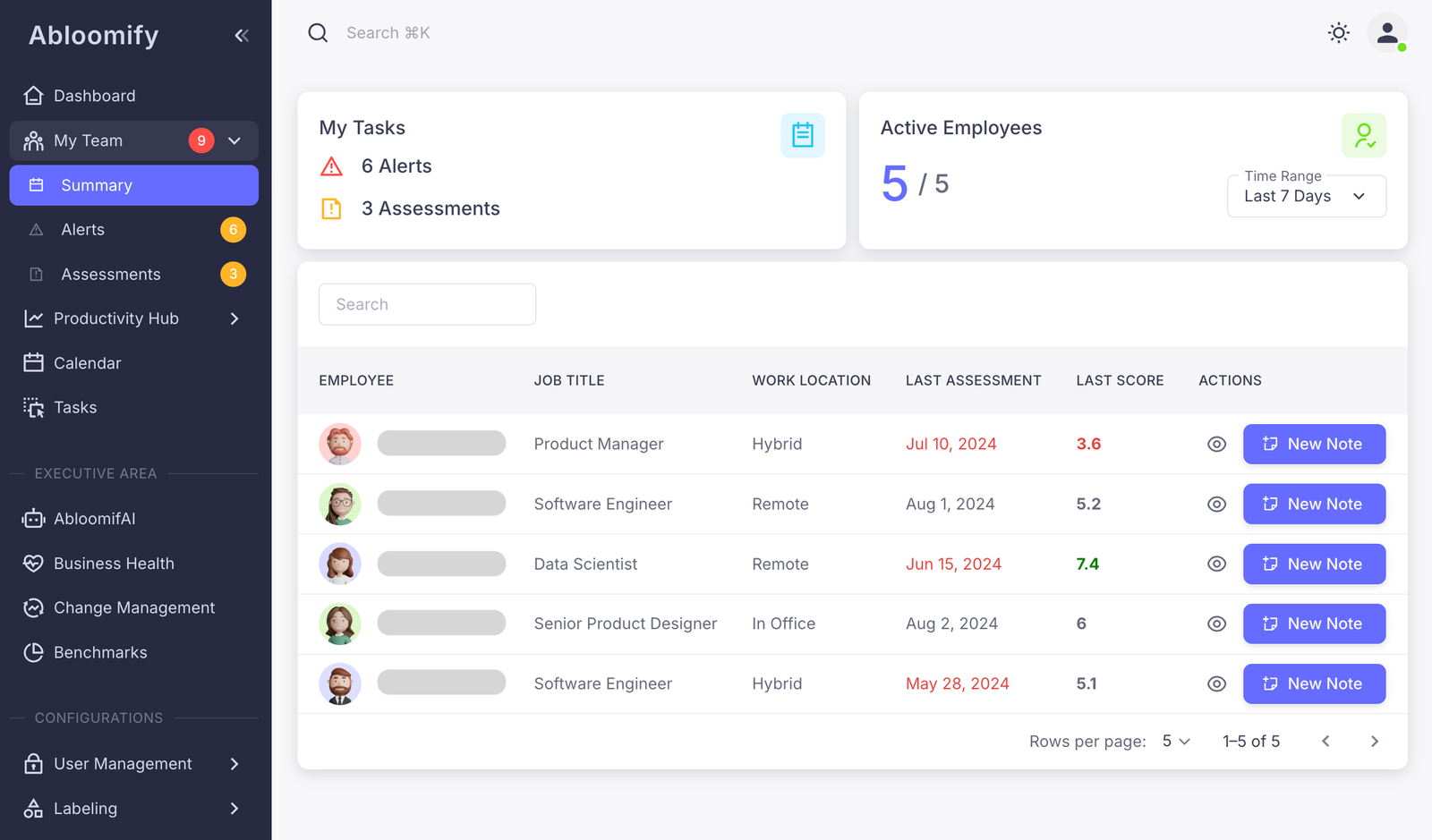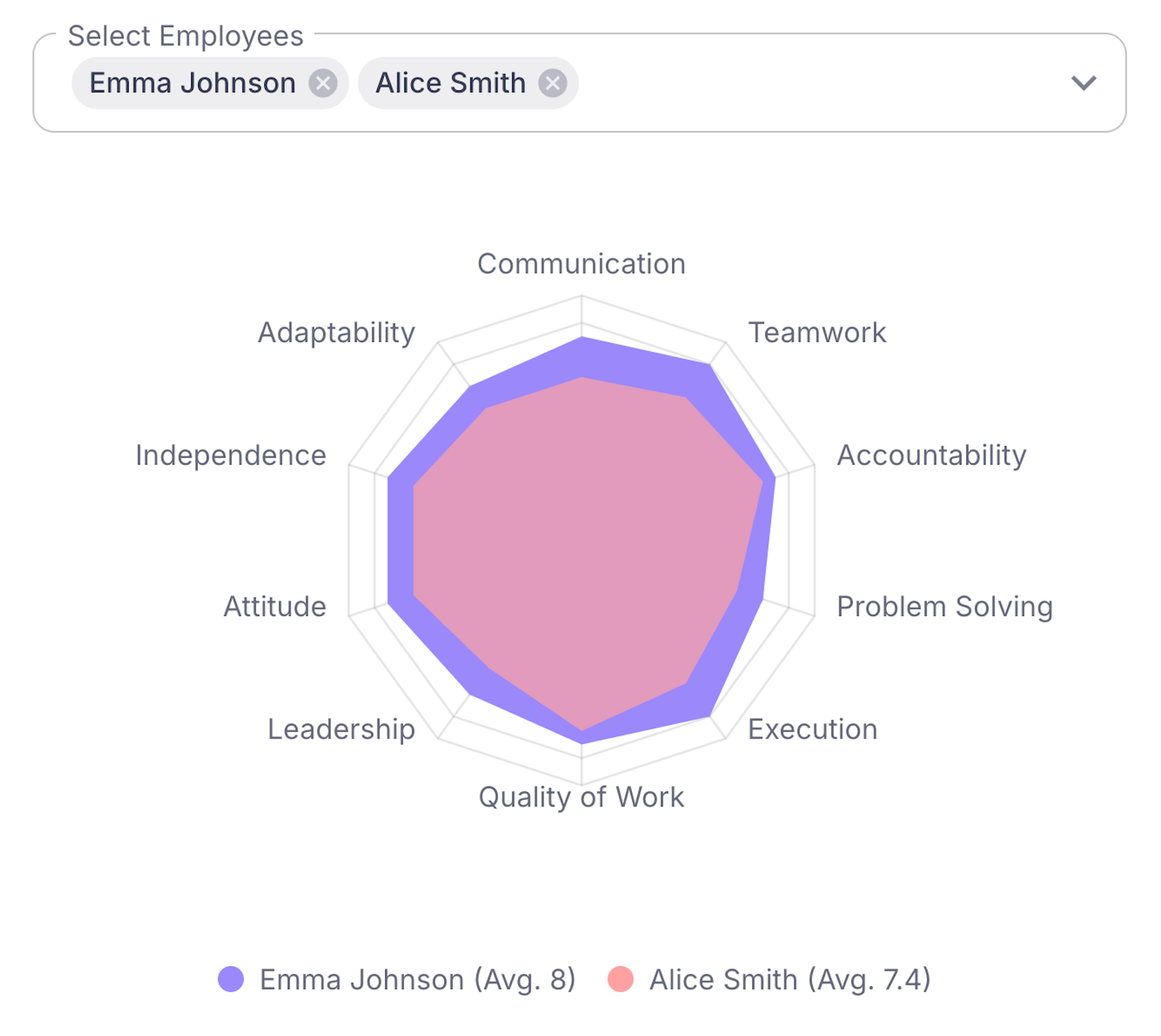Ever wonder why performance management is crucial to business success? By leveraging AI-powered tools like those from Abloomify, companies can manage teams effectively, driving sustainable growth and data-driven decision-making.
Understanding Performance Management
Picture this: You’re leading a team, aiming for top-notch performance, but something feels off. Motivation’s lacking, productivity’s dwindling, and you’re left wondering where things went astray. Enter performance management, the strategic tool designed to sharpen your team’s performance game.
At its core, performance management is about establishing a streamlined, clear-cut approach to boost team efficiency. Think of it as a GPS guiding employee efforts towards the organization’s overarching goals. When executed well, it acts like a finely tuned symphony, where everyone knows their part and plays it beautifully. This happens through a few critical steps.
First, setting clear objectives lets everyone know precisely what they’re aiming for. It’s like giving a map to a treasure—employees can chart their path efficiently. Next, monitoring progress isn’t about micromanagement. It’s about understanding where the team is on their journey and adjusting as needed. This is where data and insights truly shine. Tools that harness these metrics are invaluable for aligning work efforts with business goals.
Feedback is the final star player in this setup, fueling continuous improvement. Regular, constructive feedback transforms missteps into stepping stones toward success. By connecting tasks directly with the company’s ambitions, morale and engagement get a significant boost.
For an in-depth look at step-by-step approaches to boost efficiency, explore strategies for improving productivity in today’s dynamic workplaces.
Performance management isn’t just a system; it’s a partnership that empowers every team member to achieve more and drives the whole organization forward.
The Role of AI in Performance Management
Artificial intelligence is shaking up the way we manage performance. Imagine a tool that not only predicts burnout but also keeps you updated on potential disengagement among your employees. AI is doing exactly that. It has transformed performance management, turning a once tedious task into a streamlined process. AI-powered tools provide managers with insights that were hard to come by in the past but are essential for spotting trouble before it escalates.
Here’s how AI revolutionizes performance management:
- AI-Driven Assessments: These assessments offer real-time data analysis. Managers can quickly identify trends and patterns affecting team dynamics.
- Productivity Alerts: Think of automatic alerts that notify managers of declining performance levels or potential burnout. This allows proactive interventions.
- Automated Scheduling and Feedback: AI automates repetitive tasks, allowing a focus on actual team engagement and development.
With these tools, performance evaluations evolve from dreaded tasks to strategic overviews. By simplifying the evaluation process, AI allows managers to focus on actionable insights and meaningful conversations. This supports not just individual growth but aligns with overarching goals.
For a deeper dive into how this technology impacts performance management, check out how unleashing productivity with AI redefines workplace leadership. AI helps managers become more intuitive, efficient, and human-centered. It’s not just a tool; it’s the future of effective performance management.
Building High-Performing Teams
Imagine a team that doesn’t just meet their goals but consistently crushes them. That’s the power of effective performance management. It transforms average groups into high-performing teams that adapt and thrive. How? By helping you clearly see where everyone’s talents shine and where there’s room to grow.
A winning team is lean and resilient, and that starts with personalized career paths. Imagine a platform that guides tech companies in crafting tailored development plans. Think of it like having a GPS for each employee’s career journey. They know where they’re headed, and how they can best get there, which boosts motivation and engagement.
Creating a culture that embraces continuous improvement and collaboration is key. Here’s how you do it:
- Foster open communication and regular feedback loops.
- Encourage risk-taking and innovation without fear of failure.
- Celebrate small wins to build momentum and morale.
Such practices cultivate an agile mindset. Teams become adept at pivoting quickly when needed. This breeds confidence and a stronger willingness to tackle challenges head-on.
By utilizing tailored tools, you not only streamline processes but also empower teams to become unstoppable. It’s about transforming the potential into performance. That’s the secret sauce. And trust me, no one ever regretted investing in their team’s ability to soar. Explore more strategies on improving team productivity to make sure your team stays at the top of their game.
Balancing Capacity and Workload
Picture this: a team that feels overworked, deadlines looming like thunderclouds, and managers juggling tasks like clowns at the circus. Sounds stressful, right? That’s where workforce planning steps in, saving the day by ensuring everyone’s workload is balanced and no one is overburdened.
Effective performance management hinges on the ability to match capacity with workload. Think of it as a balancing act, where tools for capacity planning, workload allocation, and succession planning ensure the team functions like a well-oiled machine. Here’s why it’s a game changer:
- Prevents Burnout: With precise workforce planning, tasks are distributed evenly. Employees avoid the burnout that comes from being overworked, leading to a happier, more motivated team.
- Improves Productivity: By aligning tasks with team capacity, there’s no time lost to inefficiencies. Workflows become smoother, and productivity soars.
- Future-Proofs the Team: Succession planning means that when someone steps up or steps away, there’s already a plan in place. No more scrambling when key roles need filling.
Flexible work insights equip managers with the foresight to adjust and adapt to various team structures. This ensures workloads remain balanced regardless of any changes in team dynamics. To explore more about how capacity planning and workload balance can revolutionize a team’s productivity, check out insightful resources. By adeptly managing capacity and workload, businesses can ward off chaos and foster an environment where teams thrive.
Evaluating and Optimizing Technology Use
When it comes to evaluating and optimizing technology, performance management tools are like the secret sauce. They help businesses figure out what tech works, what doesn’t, and how to make it all better. Imagine having a magic mirror that shows which software is pulling its weight and which is just gathering digital dust. That’s where smart analysis tools come into play.
Ever wonder why some organizations seem to effortlessly adapt to new tech while others fumble around? The secret lies in their ability to measure and manage how technology is used. Performance management tools can highlight where your tech budget is leaking, pointing out licenses you don’t really need.
Here’s how it works:
- They track and analyze usage data, revealing if your software is over or underutilized.
- They provide insights on optimizing software investments, ensuring each dollar spent actually improves efficiency.
- They support decision-making for adopting new technologies, showing where change can add value.
Companies embracing these tools make wiser investments and avoid overpaying for unused services. A brilliant example is license usage analysis techniques that identify where to cut unnecessary costs. By refining tech-utilization strategies, businesses can focus on utilizing essential resources instead of wasting on redundant ones.
To really see how this optimizes the workplace, picture an office harnessing only the tools that maximize productivity and cut expenses. That’s the power of proper performance management. To delve deeper into optimizing your tech use, visit our guide on workforce analytics and let data guide your tech strategy.
Ensuring Privacy and Trust
Ensuring privacy and trust in performance management is no longer just a nice-to-have but a must-have feature. Urban myths often propagate fears about big brother-like oversight in workplace analytics. However, the real essence of effective performance management systems is geared towards fostering trust through privacy.
True transparency begins with how data is handled. Performance management platforms can offer aggregate insights without resorting to invasive tracking. They focus on holistic views rather than scrutinizing individual actions. Instead of zeroing in on minute details, they spotlight patterns and trends that can drive company-wide improvements.
Here’s why ensuring privacy is essential:
- Builds Trust: Employees need to feel safe and secure. Trust is nurtured when they know that data collection is ethical and privacy is protected.
- Encourages Engagement: When employees trust their organization, engagement levels increase. This translates to higher productivity and better outcomes.
- Enhances Data Accuracy: Transparent practices encourage honest feedback and more accurate data, enhancing decision-making processes.
Beyond technical measures, ethical considerations are paramount. Balancing data collection with ethical usage means prioritizing employee interests and ensuring clarity around data usage. Businesses must pave the way for trust by being open about what information is collected and for what purposes. For more insights on responsible management, check out responsible performance management.
An organization that handles data with integrity opens doors to genuine workforce collaboration. After all, in the performance management journey, trust remains the cornerstone of achieving shared success.
Harnessing the Benefits of Performance Management
Imagine you’ve got a sleek sports car sitting in the garage. You’ve got the keys, the gas tank is full. Yet, it’s just parked there when it could be devouring miles on the open road. That’s what performance management can do for your business—take you from sitting idle to racing toward real success.
Let’s break this down. Performance management doesn’t just track metrics. It’s a roadmap for strategic action. By adopting a robust framework, businesses unlock a treasure trove of benefits:
- Actionable Insights: Get real-time data that highlights where your team excels and where they stumble.
- Increased Productivity: Sharpen operational efficiency, making your team a lean, mean productivity machine.
- Focused Goals: Align everyone’s efforts toward common business objectives, creating collective momentum.
- Engaged Employees: With clear expectations and regular feedback, employees feel more motivated and valued.
Our friends at Abloomify have seen these results firsthand. Their solution connects the dots between data and strategic decisions, turning numbers into narratives that inspire action. Embracing these data-driven practices, leaders can step confidently into a future full of sustainable progress.
But data is only powerful when used ethically and with purpose. As we talked about trust in the previous chapter, consider how performance management can also foster an environment of transparency and empowerment.
In this era of rapid change, businesses that harness the power of performance management will have the upper hand. Ready to accelerate your business? Check out how performance management systems can work for you.
Final words
Performance management is crucial in cultivating high-performing teams, enhancing productivity and achieving business goals. Leverage AI-powered solutions like Abloomify’s to make informed decisions, optimize resources, and ensure employee satisfaction. Ready to transform your workforce management? Reach out to us at Abloomify.



